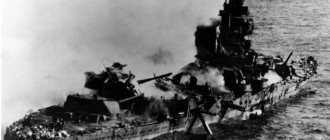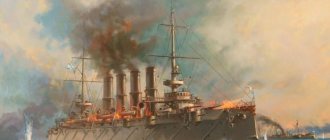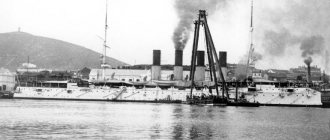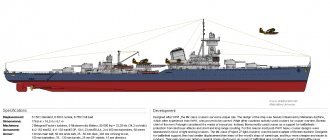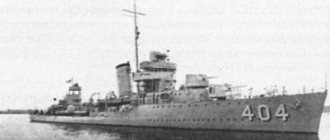Missile cruiser "Varyag"
LJ user drugoi writes: The 44th Red Banner Brigade of anti-submarine ships of the Russian Pacific Fleet is located in the very center of Vladivostok, next to the sea terminal, opposite the fleet headquarters building. Four large Project 1155 anti-submarine ships stand side by side against the wall. From here these ships go on combat duty to the Gulf of Aden, where they protect merchant ships from pirates. To the right of the four BODs is the floating hospital Irtysh, and to the left is the flagship of the Pacific Fleet, the guards missile cruiser Varyag.
The Project 1164.1 missile cruiser "Chervona Ukraine" was laid down at the 61st Communard plant in Nikolaev on July 31, 1979 (serial number 2010), on November 5, 1982 it was included in the list of ships of the USSR Navy, launched on August 28, 1983, entered service commissioned on December 25, 1989, and on February 28, 1990 included in the Pacific Fleet. After the collapse of the USSR, the cruiser went to Russia and in 1996, at the initiative of the ship’s crew, it was named “Varyag” - in honor of the famous armored cruiser of the 1st Pacific Squadron of the Russian Navy, a participant in the battle of Chemulpo in 1904. The main weapon of the cruiser is homing cruise missiles of the P complex -1000 "Vulcan". The SM-248 missile launchers are located on the sides of the ship; they look very impressive and can easily distinguish the Varyag from other ships. Project 1164 cruisers are also called “aircraft carrier killers” - in fact, that’s what they were created for.
1. The pattern of missile action is impressive - after a salvo from one side, all eight missiles, after opening their wings, form a single group, a “wolf pack” with a leader - a separately flying missile, which guides the entire group to the target, adjusts the course for the remaining missiles, dumping information on them. When approaching the target, the lead missile selects the largest object (an aircraft carrier), directs one of the missiles with the so-called at it. “special ammunition” and divides the remaining objects between the rest of the “flock” missiles. All missiles include homing heads and strike objects. The mass of one rocket is almost five tons, the flight speed is about 2900 km/h. An enemy ship has no chance of staying afloat after being hit by such a missile. If the lead missile is shot down, another one, exactly the same, takes its place. The attack takes place without the participation of the ship’s crew using a “fire and forget” system. Interestingly, all this is technology from the early 70s.
2. Acquaintance with “Varyag” begins with prosaic bags of cabbage and carrots. The Admiral Panteleev BOD standing nearby is preparing to set off on a trip to the shores of Africa and is loading a supply of food.
3. They go on sea voyages for a long time and seriously stock up on everything they need. This is only a small part of the drinking water that is loaded into the holds of a warship.
4. The officer accompanying me advised me not to use a mobile phone: “If it’s a smartphone, it’s better to turn it off, otherwise it might burn out.” I didn’t believe it, but I turned it off just in case. The ship has a full set of radar weapons of the MP-152 “Ring” complex for detecting operating radios and location stations, homing heads of enemy missiles, their direction finding and suppression. Perhaps there was some reason in the officer’s words.
5. On the forecastle of the Varyag there is an AK-130 - a ship’s automatic cannon. Fires a high-explosive fragmentation projectile at a speed of 90 rounds per minute and a range of up to 23 kilometers. Fully automatic - operates independently until the ammunition runs out. They say it has no analogues in the world. We knew how to do something, but something that shoots. There were problems with consumer goods, but the guns were always excellent. The AK-130 is no exception. In the initial sketches of the ship, there were 12 launchers (six per side) and instead of one twin-barrel gun there were two single-barreled A-100s. In 1972, Admiral Gorshkov ordered the addition of four more launchers to fire two full eight-missile salvoes, and the two AK-100s were replaced with one twin-barreled AK-130. The ship became significantly heavier, the speed and ammunition of artillery guns decreased (720 rounds versus 2000).
6. Despite modern means of communication, the signal flag system remains the main communication for watercraft in the fleet. The Russian Navy uses the code of signals of the USSR Navy. 32 signal flags correspond to the letters of the Russian alphabet: Vedi - “The course leads to danger”, Zhivet - “Give a medium move”, Y - “Detected a mine”, etc. This photo shows the signalman's position on the cruiser. The metal box contains signal flags, which, if necessary, are raised on vertical halyards to the yardarm. To the left of the box are black “running balls”, which in the sea indicate the speed of the ship. The lower the “ball” is located, the higher the speed. By the way, the Varyag can travel at a speed of 32 knots. When he goes at such speed, the breakers behind him are ten meters high.
7. “What is that little red thing turning blue?” On the wall are silhouettes of ships and planes of Russia and NATO countries. A hint for the signalman who is observing what is happening around the ship.
8. This is the wheelhouse of the ship. From here it is controlled in everyday conditions. The cabin is connected to the combat information command elevator.
9. Place of the commander of the cruiser “Varyag”, guard captain 1st rank Eduard Moskalenko.
10. Everything here really reminds us of the 70s. So reliable and iron. "Warm tube sound." I tried my best not to photograph anything secret, but go figure, where everything is.
11. “Tovs” - I love these naval words. Huys, biteng, twindeck, southwest, coaming, sternpost, binnacle - all this smells of the salty sea wind and is incredibly exciting.
12. The shifts went to their places of work. The Kavtarangs racked their brains: “What would I show you that’s so unclassified?” We agreed on some screen No. 22. Sailor Renat from Bashkortostan sat in the operator’s seat and began pressing buttons, turning on monitors - depicting the activities at the combat post. It looked quite authentic.
13. The same Renat, who caught the attention of the officers at the wrong time, enlivened the ship’s library room, pretending to be sorting out the mail that had arrived on the ship. The library is good. Small, but everything is there. In general, the Varyag is a fairly comfortable ship. The wardrooms are decorated with wood, there are paintings hanging, and carpets on the floor. There is a swimming pool with a waterfall, healing showers, a large steam room, and a sauna. The accommodation cabins are air conditioned and the ship has four air refrigeration units.
14. Walking on a cruiser involves long walks along endless corridors and sudden descents and ascents along vertical ladders. In the fourth compartment we go lower and lower, to where the sailors' quarters are. Weapons are, of course, interesting, but I really wanted to see how sailors live on one of the most powerful cruisers in the world.
15.
16. On the screen of the competition for the best cabin, you can see, for example, that cabin No. 14, which scored a bolt for the competition in December, apparently received a big star from the commanders and then became advanced, without falling below the rating of “four”.
17. This is how the night shift rests in the now exemplary cockpit No. 14. I opened the door for a couple of seconds and took a few pictures of the sleeping sailors.
18. In the next cockpit, a sailor was writing something important in a journal. Next to him stands a cage with a parrot screwed to the table. The parrot was there and resting.
19. The holy of holies of a missile cruiser is the galley. The ceilings here are low and a sailor with a rag in his hand, putting things in order, walked with his head bent, which gave his figure a sad look. Nearby, two other sailors began to open cans with a simple knife, for which they immediately received a scolding from the officers accompanying me. Everything has to be perfect for someone else's eyes, I understand.
20. A ship's cat is an indispensable accessory for any warship to combat rodents. Or, as they say here, “squirrels.” Seals and vital cables in a metal braid - these are the conditions for the coexistence of people and rodents. There are several cats on the ship; they are brought in one at a time to the combat unit. The cats of the cruiser "Varyag" are popular with guests in different countries where the ship calls. Sometimes they are given as gifts—one of the ship’s cats now lives in an Orthodox church in Singapore. Mother, they say, was happy with such a gift. Another was given to a local admiral in Indonesia.
21. I wanted to take one lifebuoy as a souvenir. They didn’t give me a government circle, but they gave me something else.
22. We had lunch with the officers, talked, then moved to the work cabin, where we talked some more. I didn’t want to leave, but time was running out for them and for me. When leaving, I took a few more pictures on the deck of the Varyag and on the shore.
23.
24. It seemed to me that everything was in order on the cruiser. He goes to sea and conducts training exercises. The Varyag is a welcome guest in foreign ports; people line up for a tour of the ship. As the officers said: “The French Mistral is parked nearby - no one is there, but to us there is a queue for the entire pier, thirty thousand people come for several days of visit.” You can see how proud the sailors are of their “Varyag” and their service. They invited me to go on a hike - I have to think about it, I’m not friends with the jocks, although I really want to, of course. Because this is real.
American miracle of technology
By the time the Russo-Japanese War began in 1904, a “shaky” mood reigned in Russian society towards the future enemy. The defeat led to the opposite result: the technical achievements of the Japanese began to be exaggerated.
This trend also affected the assessment of Varyag. At first, the cruiser was characterized as a powerful military unit, capable of “outshining” the enemy. Later, allegations appeared that this cruiser was weak and outdated. Both statements are incorrect. It was not a matter of technology, but (as they would say today) a matter of the human factor.
Naval arms race
Japan at the end of the 19th century lagged behind developed countries in technical terms, but had already managed to make a tremendous economic breakthrough.
It did not reach the level of a world power, but it was worthy competition for the leading countries of the world. Further development required resources that were not available on the cramped islands - this explains the belligerence of the young “Asian tiger”.
In 1895, Russian intelligence received information about Japan's intention to increase its fleet so that it would be superior to Russian forces in the Pacific.
This should not have been allowed - Russia itself had expansionist plans in China and Korea. The order for the construction of the Varyag ship was one of the steps to prevent Japanese domination.
American order
Import substitution was not established - Russian shipyards worked slowly. Therefore, Philadelphia shipbuilders received the order to build the armored cruiser Varyag. They undertook to do everything in 20 months. The cruiser's guns were manufactured in Russia.
According to the project, these cruisers met all the latest (at that time) requirements for a warship.
The description of the ship's technical characteristics allows us to imagine a powerful, fast, well-armed ship.
- Overall dimensions: length – 129.56 m, draft – 5.94 m, width – 15.9 m.
- Displacement - 6500 tons (design), 6604 tons (actual).
- Armor: deck – from 37 to 76 mm, conning tower – 152 mm.
- The total engine power is 20 thousand liters. With.
- Maximum speed – 24.59 knots (obtained during testing).
- Main caliber – 152 mm (12 pcs.).
- Other artillery - 24 guns (75-, 63-, 47-, 37-mm), 2 machine guns.
- Other weapons: 6 torpedo tubes 381 mm, 2 * 254 mm, 35 barrage mines, 6 throwing mines.
- Team - 20 officers, 550 lower ranks (according to the staff). In real conditions there were changes; So, at the time of the battle with the Japanese, there were 558 people on the cruiser: 21 officers, 4 conductors, 3 hired civilians, a priest, 529 sailors.
The ship had a lot of electrical equipment (new for that time) - lifts for shells, winches for boats, even dough mixers. There was a telephone connection. The furniture was made of metal, although it was painted “for the ambiance” to resemble wood. This reduced the fire hazard.
Notes
- [www.vesti.ru/doc.html?id=370171 The cruiser "Varyag" is greeted in San Francisco]
- [www.sfgate.com/cgi-bin/article.cgi?f=/c/a/2010/06/11/BAH71DSS0C.DTL Russian warship to visit San Francisco]
- [itar-tass.com/mezhdunarodnaya-panorama/531575 A detachment of ships of the Pacific Fleet headed for the Pacific Eagle exercise area]
- [www.rg.ru/2011/11/07/varyag-site.html The cruiser "Varyag" arrives in Vancouver]
- [www.novopol.ru/-rossiya-i-kitay-zavershili-voennyie-ucheniya-text122058.html Russia and China completed military exercises]
- [portnews.ru/news/159112/ Planned repairs of the missile cruiser “Varyag” have been completed (photo)]
- [itar-tass.com/politika/633157 Joint Chinese-Russian naval maneuvers “Maritime Cooperation” have ended]
- [ruwest.ru/news/5815/ A large-scale inspection of the troops of the Central and Eastern Military Districts is taking place in Russia]
- [vpk-news.ru/news/18106 The cruiser "Peter the Great" is practicing interaction with the cruiser "Varyag"]
- [www.vostokmedia.com/n185862.html On Saturday Vladivostok will welcome “Varyag”]
- [portnews.ru/news/181112/ The cruiser “Varyag” left the Chinese port of Shanghai after the “Maritime Cooperation 2014” exercise (photo)]
- [deita.ru/news/society/31.05.2014/4695192-korabli-tikhookeanskogo-flota-vstretyat-vo-vladivostoke/ Pacific Fleet ships will be met in Vladivostok]
- [www.km.ru/v-rossii/2014/07/19/armiya-i-oboronosposobnost-rossii/745261-rossiisko-indiiskie-ucheniya-v-yaponsko Russian-Indian exercises in the Sea of Japan have ended]
- [www.arms-expo.ru/news/armed_forces/ucheniya_vostok_2014_raketnyy_kreyser_varyag_naneset_udar_po_uslovnomu_protivniku_/ Exercises “Vostok-2014”: the missile cruiser “Varyag” will strike a mock enemy]
- [www.rg.ru/2014/11/15/korabli-site.html Russian ships scared the Australians]
- [flot.com/2014/178886/ “Varyag” returned to Vladivostok]
- [flot.com/2015/192791/ The cruiser “Varyag” underwent dock repairs]
- [tass.ru/politika/2509210 Russia will send the Varyag missile cruiser to Syria]
- [vpk-news.ru/news/28695 The cruiser “Varyag” became decorated]
- [tass.ru/armiya-i-opk/2569937 The cruiser "Varyag" entered the Mediterranean Sea, where it will replace the cruiser "Moscow" off the coast of Syria]
- [stat.function.mil.ru/news_page/country/ [email protected] Guards cruiser “Varyag” returned to Vladivostok from a long voyage]
Heroic retreat?
The results of the battle were not encouraging. The Japanese squadron actually suffered no losses. The cruiser "Varyag" was not blown up, but, along with documents and weapons, carefully lay down on the bottom at a shallow depth and soon joined the flotilla of the zealous Japanese.
In the report, the commander of the Varyag, Rudnev, explains the turn of the cruiser at the height of the battle as an attempt to briefly get out from under fire to repair the ship’s control mechanism and extinguish the fires that had arisen on board. However, the Japanese commission in charge of raising the cruiser from the bottom did not find any malfunctions.
In addition, in his report, the commander of the Varyag clearly exaggerated the number of salvos of deck guns. According to his information, 425 shells of 152 mm caliber were spent, but the Japanese, after conducting an audit on the captured ship, calculated the consumption not exceeding 160 pieces.
According to the recollections of one of the Varyag officers, Rudnev expected that a tribunal would await all of them upon returning to their homeland. However, Nicholas II, on the contrary, awarded everyone who took part in the battle, which caused extreme bewilderment among the officers of the tsarist army. The high command rightly believed that heroic deeds involved more than simply being on board a ship.
Interestingly, the Emperor of Japan Matsuhito also highly appreciated the heroism of the captain of the Varyag, and in 1907 he awarded him the Order of the Rising Sun, second degree. Rudnev accepted the award, but, according to the recollections of his contemporaries, he never wore it.
Performance characteristics
The main parameters of the cruiser "Varyag" are as follows:
| Displacement | 6604 tons |
| Ship length | 129.56 m |
| Width | 15.9 m |
| Draft | 5.94 m |
| Maximum speed | 24.59 knots |
| Economic speed | 10 knots |
| Fuel reserve | 1350 tons (coal) |
| Cruising range | 3270 miles at normal load, up to 6100 at maximum |
| Crew | 580 people (including 21 officers, including the commander) |
The Varyag could not always reach its maximum speed, which was due to the unreliability of the boilers, which had to be repaired almost every time after intensive use.
Content
- 1. History
- 2 Fight
- 3 Damage received during the battle and human losses[14]
- 4 Military honors in Russia
- 5 Under the Japanese flag
- 6 Return to the Russian flag
- 7 Ships named after the Varyag
- 8 Cruiser officers and officials
- 9 Monuments and memorial plaques in honor of the cruiser crew members
- 10 The image of a cruiser in culture
- 11 “Varyag” in modeling
- 12 Gallery
- 13 See also
- 14 Notes
- 15 Literature
- 16 Links
Details not included in reports
The true history of the cruiser “Varyag” reveals facts that predetermined its short life. It was built and delivered to the customer in 1899 (that is, on time), but the flag over it was only understood on January 2, 1901. The reason is that the ship immediately required modifications - the tactical and technical characteristics did not correspond to what was planned.
There were two main problems. The Nikloss system boilers installed on the ship turned out to be unreliable and often broke down. Although the Russian fleet already had experience working with boilers of this system, and they did not cause any special problems, it didn’t work out here.
For this reason, in combat conditions the ship was slower than planned, and constantly ran the risk of ending up with emergency boilers at the most inopportune moment. In practice, the speed of 26 knots declared by the manufacturers was not achieved.
Usually the ship did not even give the speed of 24.5 knots shown during tests.
Captain V.F. Rudnev complained not only about problems with the boilers, but also about other shortcomings of the manufacturer, and about a weak repair base. Probably, his information about the maximum speed of 14 knots is understated, but the Varyag did not give full speed.
In addition, the armored cruiser's guns were deprived of armor protection. This created an additional risk for the gunners and the combat effectiveness of the cruiser (it was easy for the enemy to destroy the ship’s weapons).
This lack of armor protection played a fatal role in the famous battle of the cruiser Varyag with the Japanese squadron. Most cruisers of that time had such protection, but in this case the ship was made lighter due to gun armor.
From sad experience, appropriate conclusions were drawn; other cruisers of this type (including the Aurora) had gun protection installed. But this could no longer help the “Varangian” artillerymen.
Literature
- Polutov A.V.
Landing operation of the Japanese army and navy in February 1904 in Icheon. - Vladivostok: Russian Island, 2009. - 472 p. — ISBN 978-5-93577-045-7. - Kataev V.I.
Cruiser “Varyag”. Legend of the Russian Navy. - M.: Yauza, Eksmo, Collection, 2008. - 128 p. — ISBN 978-5-699-29721-4. - Historical commission to describe the actions of the fleet in the war of 1904-1905.
at the Naval General Staff. Russo-Japanese War 1904-1905 Fleet actions. Documentation. - SPb.: Type. mor. Min-va, 1911. - T. 1. - P. 143-177. — 201 p. - Historical commission to describe the actions of the fleet in the war of 1904-1905.
at the Naval General Staff. Russo-Japanese War 1904-1905 Book one. Fleet actions in the southern theater from the beginning of the war until the interruption of communications with Port Arthur. - SPb.: Type. V. D. Smirnova, 1912. - 635 p. - Khazin A.L.
Cruiser “Varyag”: memory of generations. - Moscow, 2014. - 228 p.
